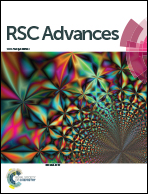An efficient magnetic copper ferrite nanoparticle catalysed ligand and solvent free synthesis of N-aryl amide from aldoximes and iodobenzene†
Abstract
A simple, efficient, and environmentally benign method has been reported for the synthesis of N-aryl amides using aldoximes and iodobenzene under ligand free and solvent free conditions and using magnetically separable copper ferrite nanoparticles as catalyst. The catalyst was characterised using XRD, FEG-SEM, EDAX, ICP-AES and TEM and tested for recyclability for up to five cycles.


 Please wait while we load your content...
Please wait while we load your content...